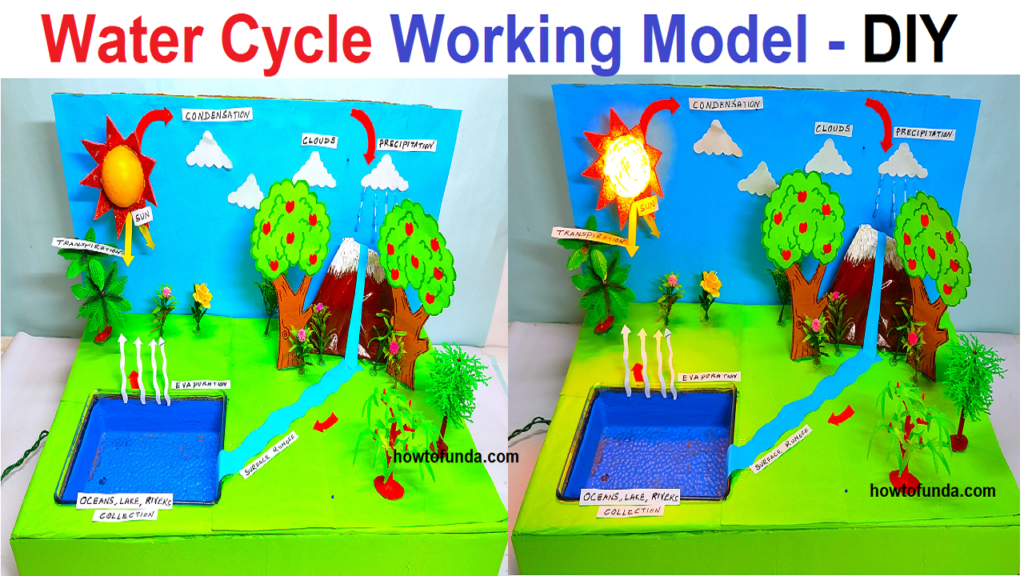1. What is the water cycle?
- Answer: The water cycle is the continuous process of water evaporating from the Earth’s surface, condensing into clouds, precipitating as rain or snow, and then flowing back to the surface through runoff or infiltration.

2. What are the main stages of the water cycle?
- Answer: The main stages of the water cycle are evaporation, condensation, precipitation, runoff, and infiltration.
3. How does evaporation occur in the water cycle?
- Answer: Evaporation occurs when the sun’s heat causes water from lakes, rivers, and oceans to change from a liquid state to water vapor and rise into the atmosphere.
4. What is condensation in the water cycle?
- Answer: Condensation is the process where water vapor in the atmosphere cools and changes back into liquid form, forming clouds.
5. How does precipitation happen in the water cycle?
- Answer: Precipitation occurs when water droplets in clouds combine and become heavy enough to fall to the Earth’s surface as rain, snow, sleet, or hail.
6. What factors influence the type of precipitation (rain, snow, sleet, hail) in the water cycle?
- Answer: Factors such as temperature, atmospheric pressure, and air currents influence the type of precipitation that occurs.
7. Explain the process of runoff in the water cycle.
- Answer: Runoff is the flow of water over the Earth’s surface, often as a result of precipitation. It can occur as surface water flows into rivers, streams, and eventually into oceans.
8. What is infiltration in the water cycle?
- Answer: Infiltration is the process by which water soaks into the ground and is absorbed by soil and rocks, eventually replenishing groundwater.
9. How does transpiration contribute to the water cycle?
- Answer: Transpiration is the release of water vapor from plants through small openings (stomata) in their leaves, contributing to the water vapor in the atmosphere.
10. How does the sun’s energy drive the water cycle?
Answer: The sun’s energy is the primary driver of the water cycle. It causes evaporation, which lifts water vapor into the atmosphere, initiating the entire cycle.
11. Explain the role of clouds in the water cycle.
Answer: Clouds form through condensation, where water vapor in the air cools and forms visible water droplets or ice crystals. Clouds play a crucial role in precipitation.
12. What is the significance of groundwater in the water cycle?
Answer: Groundwater is a vital component of the water cycle, as it sustains wells, springs, and provides a continuous flow to rivers and lakes.
13. How does the water cycle regulate Earth’s temperature?
Answer: The water cycle regulates Earth’s temperature by redistributing heat. Evaporation absorbs heat, while condensation releases heat, helping maintain a balance.
14. How does human activity impact the water cycle?
Answer: Human activities such as deforestation, urbanization, and pollution can alter the natural flow of the water cycle, leading to changes in precipitation patterns and water availability.
15. Can you describe a real-life example of the water cycle in action?
Answer: A real-life example of the water cycle is rainfall. When water evaporates from oceans, condenses into clouds, and then precipitates as rain, it completes a cycle.
16. How does the water cycle influence weather patterns?
Answer: The water cycle influences weather patterns by regulating the distribution of moisture in the atmosphere, affecting cloud formation, and influencing precipitation.
17. What is the role of oceans in the water cycle?
Answer: Oceans play a significant role in the water cycle by providing a major source for evaporation. Water vapor from oceans contributes to cloud formation and precipitation.
18. How does the water cycle impact ecosystems?
Answer: The water cycle is crucial for sustaining ecosystems. It provides water for plants, animals, and habitats, supporting the overall balance of life.
19. Can you explain how melting snow contributes to the water cycle?
Answer: Melting snow contributes to the water cycle as the solid form of water (snow) turns into liquid water, adding to surface runoff and potentially infiltrating into the ground.
20. Why is the water cycle considered a closed system?
Answer: The water cycle is considered a closed system because the total amount of water on Earth remains constant; it is continuously recycled through the various stages of the cycle.
21. How does the water cycle influence agriculture?
Answer: The water cycle is essential for agriculture as it provides precipitation needed for crop growth. Proper water management ensures sustained agricultural productivity.
22. Can the water cycle be affected by climate change?
Answer: Yes, climate change can impact the water cycle by altering precipitation patterns, increasing evaporation rates, and influencing the frequency and intensity of extreme weather events.
23. How do mountain ranges influence the water cycle?
Answer: Mountain ranges influence the water cycle by enhancing precipitation through orographic lift. Air is forced to rise over mountains, leading to condensation and increased rainfall.
24. What role do wetlands play in the water cycle?
Answer: Wetlands act as natural sponges, absorbing and releasing water. They contribute to groundwater recharge, mitigate floods, and support biodiversity.
25. How does the water cycle connect different regions of the Earth?
Answer: The water cycle connects different regions by redistributing water globally. Evaporation from one region can lead to precipitation in another, creating a dynamic and interconnected system.

